Mae Salong - village in Mae Salong Nok subdistrict, Mae Fa Luang district, Chiang Rai province, Thailand
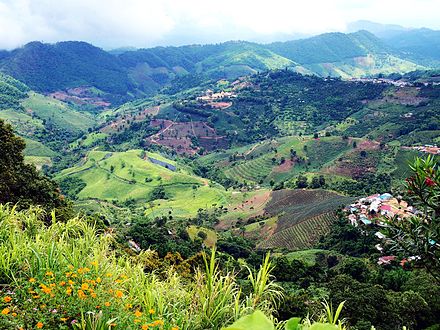
Mae Salong (แม่สลอง), also known as Doi Mae Salong (ดอยแม่สลอง) and officially called Santikhiri (สันติคีรี), is a village in Chiang Rai Province, Northern Thailand.
Understand
Mae Salong's early history centered on the opium trade of the Golden Triangle. Its recent history was shaped by the 93rd Division of the Chinese Nationalist Army that refused to surrender to Chinese communists after the Nationalist Kuomintang government was routed in 1949.
Unlike most of the unrelenting nationalists that fled to Taiwan in 1949, a force of 12,000 escaped from Yunnan to Burma and continued an insurgency against the People's Republic. They were at first supported by Taiwan and the USA, but diplomatic shifts—which included US ambivalence towards the nationalists and improved relations between Burma and communist China—later led to the partial disbanding of the nationalist forces in Burma. While thousands left for Thailand in 1961, many remained in Burma.
The soldiers who settled in Mae Salong kept it as a military base in preparation for an eventual counter-attack against communist China. They funded their arms purchases with opium production and rubbed shoulders with notorious Burmese warlord and drug baron Khun Sa, who lived a few kilometres away in Ban Hin Taek and who initially trained with the Kuomintang before founding his own army.
In the 1970s the Thai government struck a deal with the renegades: the battle-hardened soldiers would help them fight Thailand's own communist insurgents in exchange for legitimacy and Thai citizenship. Part of their going straight involved the soldiers' cessation of opium production in favour of the cultivation of mushrooms and above all oolong tea, which is now Mae Salong's main product.
Some guidebooks wax lyrical about today's Mae Salong as a miniature Yunnan Shangri-La, but if you come with this image in mind you may be a little disappointed: at first glance, Mae Salong looks much like the little Thai town it is. However, the crisp climate, the lingering Chinese influence, delicious native Yunnanese dishes and small hotels and guesthouses catering to visitors still make this a popular getaway, worth visiting even on a hurried day trip, but worth stopping in overnight.
Climate

In November, sunflowers bloom, but the peak tourist season is during Dec-Feb when the hills are alive with white plum blossoms and pinkish sakura cherry blossoms. It gets misty and cold during this time, so pack a sweater and decent shoes. Tea production gets into gear toward the end of this season, with the smell of roasting tea wafting through the streets, but the same haze and rising temperatures that affect the rest of northern Thailand are in evidence here too from March onward.
The rainy season is from June-October and is rainy indeed.
Talk
As most residents of Mae Salong are descended from Kuomintang soldiers who fled Yunnan, the Yunnan dialect of Mandarin is widely spoken here. However, virtually everybody speaks Thai as well
Get in
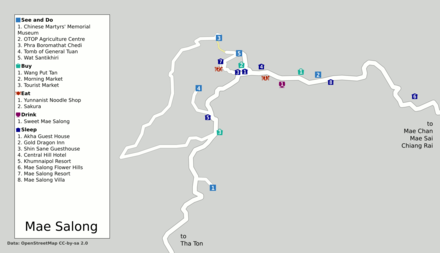 Mae Salong lies on the scenic and very twisty Hwy 1130 - pop a pill beforehand if you're prone to motion sickness.
Mae Salong lies on the scenic and very twisty Hwy 1130 - pop a pill beforehand if you're prone to motion sickness.
From the east, access is from Pa Sang (not to be confused with villages of the same name further to the North), a hamlet 32 km north of Chiang Rai on Hwy 1 / AH2, which is Thailand's main road going from its capital Bangkok all the way to its northernmost settlement, Mae Sai, on the border to Myanmar.
In Mae Salong, the 1130 bends south and ends at the junction with Hwy 1089. This highways goes in southwesterly direction through Thaton, becomes Hwy 107 and reaches Chiang Mai after some 210 km. In the eastern direction, the 1089 ends after 30 km in Mae Chan (แม่จัน), where it hits the Hwy1, 28 km north of Chiang Rai.
Public transport to Mae Salong is surprisingly spotty (especially after noon), and having your own wheels may come in handy.
By bus
 From Chiang Rai: the bus terminal near the night market has the destination of buses written in Roman letters on the green platform indicators. Take a northbound bus towards Mae Sai or to Chiang Saen. After 28 km, these buses will leave the highway AH2 to pass through the small town of Mae Chan 📍 (แม่จัน. 20-25 baht). Get off here, 120 m after the large roundabout.
From Chiang Rai: the bus terminal near the night market has the destination of buses written in Roman letters on the green platform indicators. Take a northbound bus towards Mae Sai or to Chiang Saen. After 28 km, these buses will leave the highway AH2 to pass through the small town of Mae Chan 📍 (แม่จัน. 20-25 baht). Get off here, 120 m after the large roundabout.
You will see green songthaews which leave at the scheduled times of 07:30, 09:00, 11:00 and 13:00 for Mae Salong (60 baht, at least 60 min), arriving between the Guesthouses Shin Sane and Little Home. Sometimes, you will have to change vehicle at the half-way point Kiwsatai (20.10327 99.61750), count in some time for waiting around there. After 13:00 the songthaews might still be around, but you must negotiate departure time and price (8*60 baht corresponds to a "full" songthaew).
Blue songthaews hang around between 6:00 to 17:00 at the market (20.14947 99.85283), 120 m west of where you got off. They go to Mae Salong's 7-Eleven shop taking route 1130 (60 baht. 1 hour). They do not have scheduled departures, but leave when full. Unless you are willing to pay for the non-occupied of the 8 seats, it can be a long wait, especially off-season and after noon.
From Thaton (ท่าตอน), there are yellow songthaews that go directly to Mae Salong, but only four times a day.
For the return trip, there are four scheduled green songthaews (among them one at 11:00 and the last one at 15:30) and four yellow ones. Both of them share the same route down to Kiwsatai (20.10327 99.61750). Thus, if you want to go to Chiang Rai (south) or Mae Sai (north) you may take whatever comes first down to Kiwsatai (30 baht) and change there for Mae Chan (another 30 baht). from where you can continue by bus.
In a pinch (or if in a hurry), the motorcycle cabbies can ferry you to Pasang (on the Chiang Rai to Mae Sai Main Road, 3 km north of Mae Chan) for 300 baht.
By car
The shortest access is via Hwy 1089. Coming from the road's end on the Hwy 1, the signposted turn off is after 28,6 km next to a police station (7,5 before that, there is already a turn off leading to Mae Salong, but it's a bad road). From here travel about 13 km on some of the most amazingly curvy roads imaginable.
The return trip to Mae Chan can be undertaken on Rte 1234 and Rte 1130 which wind through Yao and Akha hill tribe villages; you can also make a diversion north to visit the royal development projects and villas of Doi Tung.
By taxi
You can also hire a car with a driver from a travel agency or even hail a taxi from the street. Price in high-season is around 1200 to 1600 baht from a travel agency (edited in 12/31/17). This can be a more straightforward alternative than dealing with local transport.
Get around
Mae Salong is quite spread out, and while you can cover the central sights on foot, it is very convenient to rent a motorbike to motor around the hills and valleys. Rental cost is about 200 baht per day. Bikes come with empty tanks, so you need to fuel up first.
See
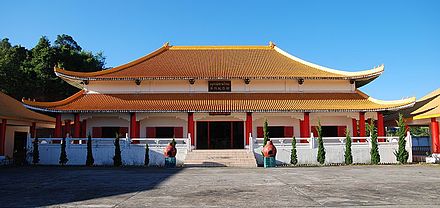
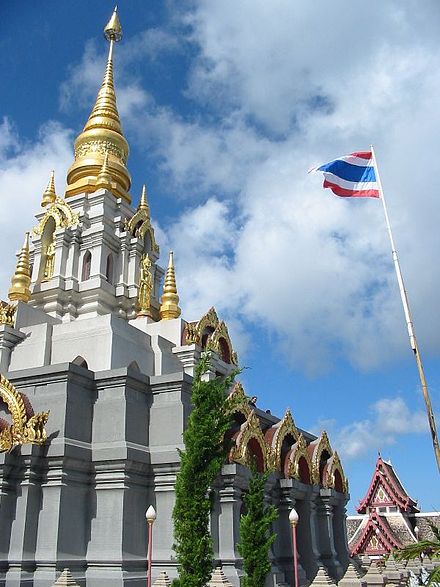
- Chinese Martyrs' Memorial Museum, 20.152388°, 99.621704°. A tribute to the Kuomintang settlers of Mae Salong who fought and died for Thailand. It exhibits their history and the development of Mae Salong. There is detailed information in Thai, Chinese and garbled English.
- OTOP Agriculture Centre. This grandly named — but mostly closed — hut features a map of the nearby tea plantations and a thermometer. This viewing point is primarily a handy reference if you have your own wheels and want to do a round of the plantations.
- Phra Boromathat Chedi. A chedi (Thai-style stupa) built on a hill near Mae Salong village, in honour of the late Princess Mother, Srinagarindra. Next to the chedi is the Princess Mother Hall, a modern, Thai-style pavilion outwardly like a temple in appearance, but not containing any religious objects. There are good views across town and west towards Myanmar from the top. There are two ways up top: on foot, follow signs from the village center up the hill towards the Mae Salong Resort and Wat Santikhiri, turn to the right into a parking lot next to a smaller temple, and then go up the steep 719-step staircase. If you find yourself at the resort, you have gone too far, back up to find the parking lot. One can also drive to the top, as there's a winding, steep road that starts from behind the tourist market and curves up from behind, with breathtaking hilly views along the Myanmar border.
- Tomb of General Tuan. The mausoleum of Mae Salong's founder and erstwhile drug warlord, Kuomintang General Tuan Xi-Wen. At the end of a road beside a tea house with General Tuan's name, up another steep staircase. There's a small museum here, but unfortunately it's all in Chinese. There are some tea houses nearby, and you can enjoy a spectacular view of Mae Salong there.
- Wat Santikhiri. A modern, standard-issue Thai temple guarding the approach path to the Phra Boromathat Chedi. The more interesting parts of the temple lies across the street leading to the Mae Salong Resort. Peek inside for a nice little Chinese-style pavilion.
- Khun Sa Old Camp, 20.248629°, 99.663914°. In a nearby village is the supposed former headquarters of the druglord Khun Sa. The dilapidated museums have been turned into a small museum about how the drug trade helped the community, with slight ethno-nationalist undertones. However, all of the information is written in Thai or Shan. Ask a tour guide in Chiang Rai to call ahead of your visit, as you'll need a local to unlock the doors to the buildings for you. 2022-10-26
Do
There are many tribal villages (mostly Akha) within easy reach of Mae Salong, and local guesthouses can arrange treks in the area, either on foot or by horse (400 baht for 4 hours).
For those who would prefer to get involved, consider joining the volunteers working in the nearby Akha village. There is no charge or donation required and you can work as little or as much as you like. The volunteers stay at Shin Sane Guesthouse, so ask about the project there or find it on Facebook by searching for "Akha Hill Tribe Project - Mae Salong."
Buy
The thing to buy in Mae Salong is the excellent local oolong tea, grown on plantations all around. The tea bushes here was originally imported from Taiwan, well-known for its high mountain (gaoshan) teas grown in a very similar subtropical climate. As well as tea itself, tea sets from China as well as candies, fruits, and everything else you'd need for enjoying tea Chinese-style are also available.
- Wang Put Tan. One of the largest producers in the area, you can see the giant golden teapot guarding their plantations in the fields below their flagship store. Various grades of oolong available, from 200 to 1,000 baht per 100 g, and they'll be happy to serve up a sample.
For Akha handicrafts, Yunnanese street snacks and cheap Chinese imports, check out the two markets in town.
- Morning Market. True to the name this place opens at the crack of dawn and most of the action is over by 08:00, making this a great place for an early breakfast. A few shops do stay open until noon and beyond.
- Tourist Market. Opens in the afternoons on the south side of town, with Akha selling local produce (tea, mushrooms, herbs) and knick-knacks to tourists.
Eat
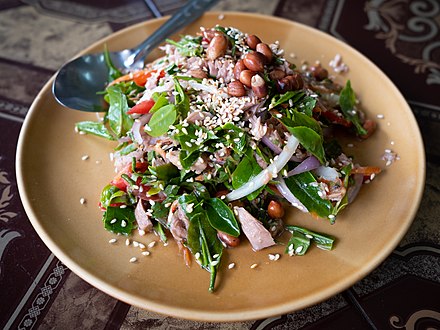 Take a break from Thai food and try out some Yunnanese cuisine. Dishes worth trying include:
Take a break from Thai food and try out some Yunnanese cuisine. Dishes worth trying include:
- Yunnan noodles with dumplins
- Papa cake, baked glutinous rice with sweet or sour sesame fillings, outside the Morning Market
- Hot soy milk with deep fried dough sticks (油条 yóu tiáo) at the Morning Market
- Bamboo worm for the brave. Deep fried and dried, it tastes like crispy biscuit.
Budget
There are a large number of noodle shops around town.
- Yunnanist Noodle Shop. The English language sign may sound a little unfortunate, but their 40-50 baht noodles soup are pretty good and served with free, tasty oolong tea. 2018-02-22
Drink
 Aside from a few dodgy karaoke enterprises, there is virtually no nightlife in Mae Salong. Drink tea instead! Or, if you're feeling frisky, sample any of the numerous Chinese liquors with unfortunate pickled bugs and snakes inside.
Aside from a few dodgy karaoke enterprises, there is virtually no nightlife in Mae Salong. Drink tea instead! Or, if you're feeling frisky, sample any of the numerous Chinese liquors with unfortunate pickled bugs and snakes inside.
- Sweet Mae Salong, 20.16491°, 99.63170°. If all that tea is starting to get to you, drop into this little wood-panelled cafe for an espresso, some home-baked cakes and pastries, plus great valley views from the terrace.
Sleep
Outside peak season supply tends to exceed demand and prices are usually negotiable.
Budget
- Akha Guest House. As the name promises, this operation is run by Akha tribes people, who also arrange treks to their villages. 200 baht single/400 baht double with shared bathroom 2018-02-22
- Gold Dragon Inn (โกลดราก้อน อินน์), +66 53 765009. 26 rooms. 300-800 baht
- Little Home Guesthouse, +66 53 765389, go_littlehome@hotmail.com. Very nice place run by a terrific family who are always happy to help or give any information you might need. Rooms from 200-300 baht; bungalows 520-800 baht depending on season
- Shin Sane Guesthouse. The name means Number 1 in Yunnanese, and it's no idle boast, as this place was the first guesthouse in Mae Salong when it opened back in the 1970s. It's still a pretty good budget option. The bungalows in the back are quieter. Rooms from 200 baht 2018-02-22
- Saeng A Roon Hotel, 25/3 Doi Maesalong (Opposite the little home guest house), +66-89-1122808, +66-89-8922732. Clean rooms with WIFI and hot showers, private and shared bathrooms available, 500 Baht.
- Mr. Ho Guesthouse, 1130, Tambon Mae Salong Nok, Amphoe Mae Fa Luang, Chang Wat Chiang Rai 57110 (Downhill from 7eleven, just before Yunnanist Noodles Rest.), +66 871851978. Nice new brand guesthouse, clean and comfortable. Restaurant at the entrance. The owner speaks very good English and will be pleased to tell you what to do in town. Double 200, Triple 300. With bathroom attached 2018-02-22
Mid-range
- Baan See See Mountain View (บ้านซือซือ), 18/3 Moo 1, +66 53 765053. 12 bungalows. 400-1,000 baht
- Central Hill Hotel (เซ็นทรัล ฮิลล์), 18/4 Moo 1 (Opposite 7-Eleven), +66 53 765113. It doesn't get more central than this. Small, but clean, rooms with good views out into the valley. 19 rooms. 500+ baht
- Khumnaipol Resort (คุ้มนายพล รีสอร์ท), 58 Moo 1, +66 53 765001. 20 rooms. 600-2,500 baht
- Mae Salong Flower Hills, +66 53 765496. The newest and nicest of the mid-range places, you'll see the breathtaking sloped flower gardens if arriving from the east. The 1,500 baht rooms are overpriced as each bungalow partly obscures the view of its neighbour and there is a long walk up 2 flights of steps to get there. Another downside is the location, a fair hike away from town. 800-1,500 baht
- Mae Salong Resort (แม่สลอง รีสอร์ท), 3/8 Moo 1, +66 53 765014. Easily the most historic of Mae Salong's hotels, this place used to be a KMT military training camp and some of the army green and brown bungalows look the part. However, these days it's a little under-used and the older buildings are pretty grotty. Ask if they can give you a deal on the newer, nicer ones. There's a small but mildly interesting photo exhibit on the KMT and nice views down towards town. At Sakura, the in-house restaurant, try the Yunnanese food, especially the mushroom dishes, made with mushrooms grown on premises. 500-2,000 baht
- Mae Salong Villa (แม่สลอง วิลล่า), +66 53 765114. A tarted-up concrete block with a good Yunnanese restaurant with a terrace plus its own tea shop. 60 rooms. 800-1200 baht
- Osmanhouse (Baanhommuenlee) (บ้านหอมหมื่นลี้), 90 หมู่1, +66840458031, baanhommuenleehotel@gmail.com. Check-in: 14:00, check-out: 12:00. 1,390-2,190Baht 2019-07-12
Stay safe
Any opium warlord action has long since moved across the border to Myanmar. Still, this is a border area, so don't go trekking too close to the boundary and keep your papers with you as there are plenty of police checkpoints around.
Go next
Santikhiri
Timezone:MultipleCoordinates:20.17, 99.62

